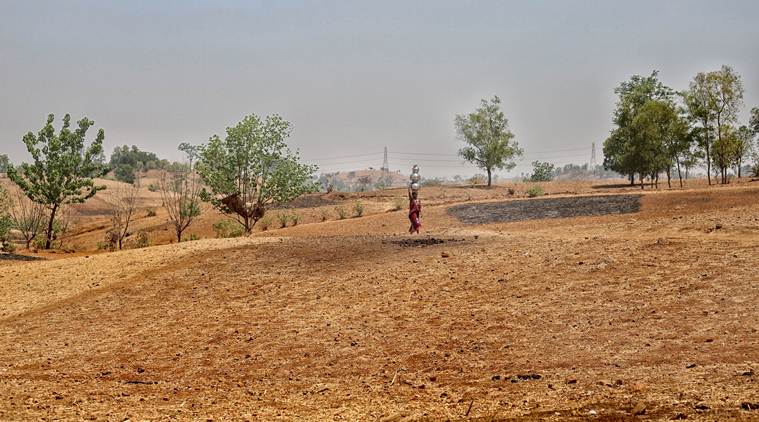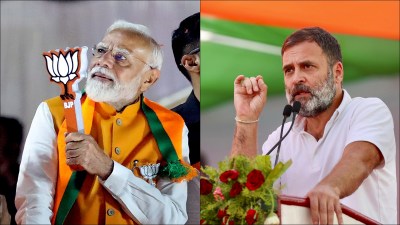- India
- International
Explained: How severe is the water crisis in Maharashtra? What measures has the government taken?
Record number of tankers are sole source of water in large parts of state. Behind the crisis, late monsoon following a deficit year, depleting groundwater in 279 talukas, under 10% live storage in 13 key reservoirs.
 A parched area in Palghar district, where villagers often walk miles to fetch water. (Express photo by Amit Chakravarty)
A parched area in Palghar district, where villagers often walk miles to fetch water. (Express photo by Amit Chakravarty)
Maharashtra is facing a water emergency of unprecedented proportions. Following years of drought, the rivers’ currents have ebbed, water in dams and reservoirs has depleted and over-exploitation of groundwater has raised concerns over the long-term availability of water.
With the weather department forecasting a delayed onset of monsoon, the state government has now deployed the highest ever number of water tankers — 6,597 as of June 10 — to meet the drinking water needs of parched regions. This is over three times the number of tankers deployed around this time last year (1,777). In 2016, due to another deficient monsoon, 6,016 tankers were deployed during peak scarcity.
How severe is the water crisis in Maharashtra?
Until June 3, residents of 5,127 villages and 10,867 hamlets were solely dependent on tanker water supply for their daily needs. Between May 20 and June 3 alone, 512 villages and 728 hamlets were added to the list of areas being catered.
More than half the tankers have been deployed in Marathwada, which is the worst-hit region. These include 1,146 tankers in Aurangabad, where more than 761 villages are facing water shortage, and 939 tankers in Beed (652 villages).
In North Maharashtra, 822 tankers have been deployed in Ahmednagar and 358 in Nashik. In Western Maharashtra with its drought-prone belts, Solapur is the worst-hit with 275 villages and 1,671 hamlets facing a shortage. The water scarcity has also hit livestock, with about 10.68 lakh animals sheltered in cattle camps for fodder and water needs.

 In Palghar’s Mokhada. (Express Photo: Deepak Joshi)
In Palghar’s Mokhada. (Express Photo: Deepak Joshi)
How much water is stored in reservoirs in Maharashtra?
Out of 17 major reservoirs listed by the Central Water Commission (CWC), with a total live capacity of 14.073 billion cubic metres, the live storage until June 6 is just 0.778 BCM, or 5.5%. A CWC bulletin listed live storage as nil in five of these —Paithon, Bhima (Ujjani), Yeldari, Upper Tapi and Pench. In eight more reservoirs, current live storage was between 1 and 10%. Only Khadakvasla (39%), Bhatsa (28%), Upper Vaitarna (15%) and Upper Wardha (14%) had more than 10%.
How depleted are groundwater levels?
The latest survey of the Groundwater Survey and Development Agency found that of Maharashtra’s 353 talukas, 279 have experienced depletion in ground water levels. Parts of Marathwada and North Maharashtra are among the worst-hit. In 2,642 villages across the state, groundwater levels were found to be more than 3 metres lower than the five-year average — a pointer to uncontrolled extraction of water and damage to groundwater aquifers. GSDA officials blame non-implementation of the Maharashtra Groundwater (Development and Management) Act, which was enacted to regulate extraction. With food production in rain-shadow belts also dependent on groundwater use, depleting water levels are putting the state’s harvest at risk.
How dry has the weather been?
In weather regions as classified by the India Meteorological Department (IMD), Marathwada had annual rainfall of 601.5 mm in 2018 (27% short of the normal of 821,6 mm), Madhya Maharashtra had 744.3 (15% short of 876.8 mm) and Vidarbha had 923.9 mm (15% short of 1,084.5 mm).
The forecast, however, is for a “normal monsoon outlook” (96-104% of long period average). In a presentation to Chief Minister Devendra Fadnavis last week, the IMD forecast that a full-blown monsoon would hit Mumbai’s coastline by June 17, and spread to the rest of the state within hours. The forecast for pre-monsoon rain spells is weak.

Govt Report on rabi, kharif crops: As Maharashtra reels under drought, sugarcane production increases
Besides deploying tankers, what measures has the Maharashtra govt taken?
Last week, the Cabinet sanctioned a Rs-30-crore proposal for cloud-seeding experiments in dam catchment areas of Marathwada, North Maharashtra, and Vidarbha. “We will undertake the experiments, if required, based on the advice of experts,” said Kishore Raje Nimbalkar, Secretary, Relief and Rehabilitation.
The effectiveness of cloud-seeding has been questioned ever since India’s first such experiments in in Tamil Nadu in 1983. Maharashtra first tried it in 1992, in the catchments of dams that supply water to Mumbai. In 2015, the state conducted 47 aerial runs and contended that these induced about 1,300 mm rainfall.
In 2017, Chief Minister Fadnavis had set 2019 as the year to make Maharashtra tanker-free as a result of water conservation works, with community participation, under the flagship initiative Jalyukt Shivar. With the deadline missed, the Opposition has been questioning the way the initiative is being implemented. Nimbalkar said, “While the state is facing a severe drought and water shortage, adequate mitigation measures have been put in place. Implementation is being monitored at the highest level. A water management plan is in place till the monsoon sets in.”
Fadnavis recently directed senior bureaucrats to visit water-parched areas for reviewing the implementation of various works. The government has taken up repair and restoration of water supply schemes and acquisition of wells in affected areas on priority.
More Explained
EXPRESS OPINION
Apr 25: Latest News
- 01
- 02
- 03
- 04
- 05










































